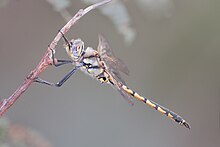Tau emerald
Appearance
| Tau emerald | |
|---|---|

| |
| Male | |

| |
| Female | |
| Scientific classification | |
| Domain: | Eukaryota |
| Kingdom: | Animalia |
| Phylum: | Arthropoda |
| Class: | Insecta |
| Order: | Odonata |
| Infraorder: | Anisoptera |
| Family: | Corduliidae |
| Genus: | Hemicordulia |
| Species: | H. tau
|
| Binomial name | |
| Hemicordulia tau | |

| |
The tau emerald (Hemicordulia tau) is a species of dragonfly in the family Corduliidae.[3] It is found in all parts of Australia except northern Queensland and north-western Western Australia.[4] The species was first described by Edmond de Sélys Longchamps in 1871.[2]
The tau emerald is a medium-sized, black and yellow dragonfly with long legs,[5] reaching a body length of about 50 mm.[6] In both males and females the inboard edge of the hindwing is rounded.[5]
Gallery
-
In flight
-
Female
-
Female
-
Male
-
Mating pair
-
Female wings
-
Male wings
References
Wikimedia Commons has media related to Hemicordulia tau.
Wikispecies has information related to Hemicordulia tau.
- ^ Dow, R.A. (2017). "Hemicordulia tau". IUCN Red List of Threatened Species. 2017. IUCN: e.T83306426A83375516. doi:10.2305/IUCN.UK.2017-1.RLTS.T83306426A83375516.en. Retrieved 15 December 2017.
- ^ a b Selys-Longchamps, Edmond (1871). "Synopsis des Cordulines". Bulletin de la Classe des Science, Academie Royale de Belgique. 2 (in French). 31: 256 – via Biodiversity Heritage Library.
- ^ "Species Hemicordulia tau (Selys, 1871)". Australian Faunal Directory. Australian Biological Resources Study. 2012. Retrieved 28 January 2017.
- ^ Günther Theischinger and John Hawking (2006). The Complete Field Guide To Dragonflies Of Australia. Collingwood, Victoria: CSIRO Publishing. p. 249.
- ^ a b Watson, J.A.L.; Theischinger, G.; Abbey, H.M. (1991). The Australian Dragonflies: A Guide to the Identification, Distributions and Habitats of Australian Odonata. Melbourne: CSIRO. ISBN 0643051368.
- ^ http://www.brisbaneinsects.com/brisbane_dragons/TMark.htm








